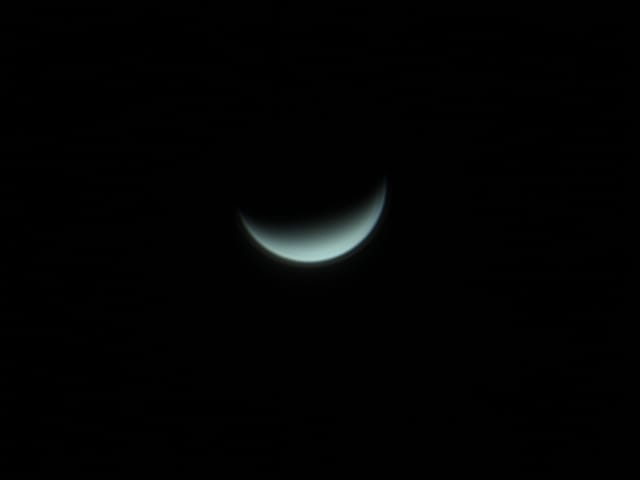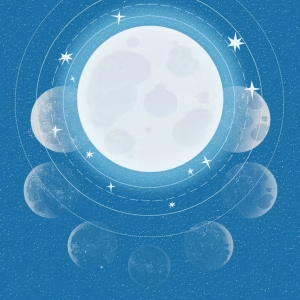Seeing Venus through a telescope is a surprisingly rewarding experience, even with simple equipment. Thanks to its bright brightness and relatively short distance from Earth, Venus is one of the most popular objects among novice and experienced stargazers alike. But what exactly do you see? And what telescope do you need?
What do you see when you view Venus through a telescope?
When you Venus through a telescope view, you see no craters or solid surface details like on the Moon or Mars. The planet is completely covered by a dense atmosphere of sulfuric acid clouds. That makes it impossible to see the surface directly with optical telescopes. What you do observe:
✓ A bright, yellow-white disc with a moon-like phase (crescent, half or nearly full)
✓ A distinct shape depending on the position of Venus relative to the sun
✓ Subtle atmospheric effects, such as a blurred edge or soft transitions
✓ For larger telescopes: indications of cloud bands or variation in brightness
Venus' atmosphere is extremely dense and hot, with temperatures above 460 °C, Venus is hot enough to melt lead. But what many people don't know: there are strong indications that Venus may have been habitable billions of years ago. Scientific models suggest that Venus had a temperate climate and liquid water on its surface before a drastic greenhouse effect turned it into the fiery world we see today. This makes Venus especially fascinating to astronomers and planetologists.
With a telescope starting at 60 mm aperture, you can already clearly see how Venus moves through phases. These changes - from thin crescent to crescent - occur because Venus, like the Moon, exhibits different angles of illumination during its orbit between Earth and Sun.




Can you see Venus without a telescope?
Yes, Venus is visible to the naked eye and is known as the evening star or morning star, depending on when she appears. Thanks to an apparent magnitude between -4.6 and -3.8, Venus is sometimes visible even during the day if you know where to look. But to see the phases and shape of Venus, you need a telescope.
What type of telescope do you need?
To see Venus properly through a telescope, the following applies:
✓ Minimum opening: 60 mm (e.g., a small refractor)
✓ Recommended opening: 90-130 mm for more detail
✓ Ideal magnification: Start around 50x and magnify to 100-200x in good conditions
✓ Filters: A neutral gray filter or variable polarizing filter Helps dampen bright glare
✓ Timing: Venus is best viewed when it is high in the sky, preferably at maximum elongation (in other words, when it is farthest from the sun in the sky)
Note that the brightness of Venus is so bright that the image is often irradiated. Preferably use a moon filter or variable ND filter to enhance contrast.
When is Venus most visible?
The best times to view Venus through a telescope are around the maximum elongation - the point at which Venus is farthest from the sun in the sky. This happens about every 584 days. At that time, you will see a distinct half or crescent-shaped Venus and it is relatively high in the sky. Look preferentially:
✓ In the early evening (at evening elongation)
✓ Or in the early morning (with morning elongation)
✓ In clear weather and low air pollution
For example, check out this external source from NASA's Venus data for exact times and positions.
Practical tips for observing Venus
✓ Start with low magnification to find Venus quickly
✓ Then use higher magnification (up to 200x) for phase details
✓ Use a good Barlow lens to enlarge the image without losing too much quality
✓ Preferably look from a location with low light pollution
✓ Let your telescope acclimate to the outside temperature first to avoid thermal distortion
For a good view of Venus, for example, we recommend these Omegon telescope to (for beginners) or a larger Sky-Watcher Heritage 130/650 If you want to see more detail.
Can you photograph Venus?
Yes, definitely. Even with a smartphone adapter on a small telescope, you can capture the crescent-shaped appearance of Venus. Want more detail? Then use a camera with manual settings, a T-adapter, and process your images with stacking software such as RegiStax or AutoStakkert.
Conclusion
Viewing Venus through a telescope is easy, educational and impressive. Don't expect a surface full of details, but do expect a bright, dynamic object that moves beautifully through its phases - just like the moon. With a telescope of 60 mm or more, a good filter and a little patience, you'll get a clear view of our sister planet.
Want to make sure you choose the right telescope for Venus as well as other planets? Check out our stargazing choice guide.







